Traveling the Draa Valley to Zagora, with a detour to N’Kob – Morocco
Traveling the Draa Valley to N’Kob town – Agdz and Tamnougalt
Short Description. In Ouarzazate, I went to the kasbah in the town center and then to the old film studios. After that, I drove along the Draa Valley and stopped at the Caid’s family kasbahs in Agdz and Tamnougalt. Further on, I made a detour to N’Kob where I stayed overnight in a camping ground.
Long Description.
The city of Ouarzazate was the main commercial center in the region, and the artisans’ souq stood just opposite Kasbah Taourirt. In front of the kasbah, a new pack of insistent guides assailed me, and I had a hard time getting rid of them. The enormous kasbah had most rooms without furnishings but it had richly colored decorations – ceramic tiles, laborious stuccoes on the walls, as well as painstakingly painted wooden ceilings. I almost got lost amidst the dozens of courtyards, terraces, and intricate floors in the kasbah.
Numerous movies had been cast in the kasbahs in the area and the Atlas Film Studios in Ouarzazate. A few former rectangular mud-brick studios hosted the Cinema Museum and had dusty cardboard decors with mottled colors. Most of the rooms displayed various film scripts, with music and historical characters, medieval costumes, sphinxes, lions, and winged horses.
From Ouarzazate, the road along the endless Draa Valley went to the Sahara Desert. The desert scenery scarcely dotted with isolated palm trees undulated along the ridges of gentle hills, among which the road meandered infinitely. Lush green oases burst along the valley in places where water sprang after coming as far as from the High Atlas Mountains. Defensive kasbahs had been built in the proximity of the oases as outposts on the caravan routes. Their role had been to protect the oases (valuable places with water sources) and to stop the French colonization.
Numerous mud-brick kasbahs were perfectly preserved in the palmeraie of Agdz. At Kasbah Caid, Rachid (a member of the Caid clan) guided me through the rooms of his family kasbah. The Ait-el-Caid clan, a noble family, had 250 members. They all met only at weddings and parties taking place in the vast courtyard of the kasbah. Besides, the family owned four other kasbahs in the region – all of them still inhabited.
The kasbah in Agdz had 40 rooms, but only 14 persons lived there at that moment. Rachid’s grandfather had been a wealthy man and had afforded ten wives. Each wife took care of all children of the family (including the children of other wives). Eventually, Rachid said that he and his cousin, Talal, had had a small role in the movie Babel starring Brad Pitt.
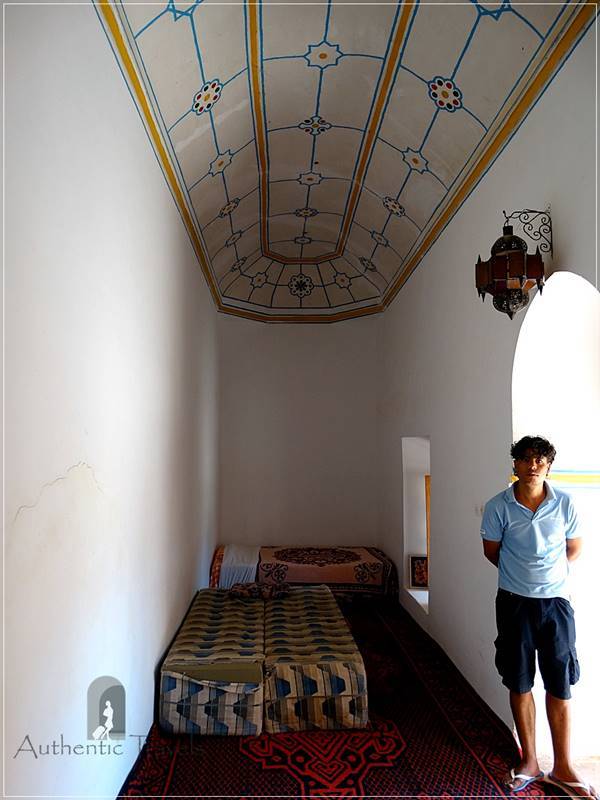
Agdz: Ait El Caid family kasbah. Rachid was my guide, and he told me he played the scene serving tea to Brad Pitt in the film Babel
Rachid also sent me to Tamnougalt – a fortified village dating back to the 16th century, where his cousin showed me another kasbah of the Caid family. Talal dusted himself off when he stood up from the ground. Then he guided me through the corners of his family kasbah.
The kasbah in Tamnougalt was the first one built in this area during the 16th century, but only 24 members of the family lived there at that moment. They slept on mattresses directly on the ground and baked bread in earth ovens. Moreover, Talal explained to me the differences between the Arab, Andalusian, and Berber architecture – all three being visible in the three inner courtyards of the kasbah. After that, Talal showed me the surrounding ksar, and then another neighboring kasbah refurbished as a guest house. Eventually, he gifted me a pendant with a colorful embroidered small Arabic slipper.
From Tamnougalt, I made a small detour through a desert area where wild camels randomly walked on the side of the road. Eventually, I reached the town of N’Kob – called the ‘Town of the Oases and the 45 Kasbahs’. At Kasbah Baha Baha, a Moroccan dressed in a white djellaba accompanied me like a wandering ghost through the rooms of the kasbah. The kasbah had a large garden with a swimming pool, Berber tents, and a small ethnographic museum. The main building featured many stylish guest rooms carefully designed with Berber decors.
In the evening, I went to Camping Ouadjou on the outskirts of N’Kob, where I was their only guest. A cat stuck to me during the whole evening, and the staff spoiled me with two kinds of tajine in the pavilion near the beautifully illuminated pool.
Traveling along the Draa Valley – from N’Kob to Zagora
Short Description. I explored the kasbahs scattered amidst the oases in N’Kob. Then, I returned to the Draa Valley and stopped at the kasbah-museums in Oulad Othmane and Ksar Tissergat.
Long Description.
I felt sick after eating the kefta tajine (a mixture of minced meat and vegetables) the previous evening. Nevertheless, I wandered among some of the 45 kasbahs scattered throughout the palm oases in N’Kob. On the main street, I noticed different meats exposed in the sun and thus understood the reason for my food-poisoning. On secondary streets, with sand and a lot of dust and debris, an enclosure of a fortified fortress surrounded by palm trees appeared all of a sudden. Imposing luxurious kasbahs rose next to dilapidated houses and defied any expectation.
From N’Kob, I returned on the same route to the Draa Valley and continued farther south along the valley rich in vegetation, ksars, and kasbahs (more than 360 throughout the valley). The Draa Valley was the second-largest palm grove in Africa. It had been the main route for trading caravans traveling between Saharan and Sub-Saharan Africa (Timbuktu in Mali, Niger, and Senegal) toward North Africa and Europe. The inhabitants lived on agriculture (dates, henna), sheep, and camel herding.
It was hot, and I had to turn on the air conditioning inside the car. Locals themselves didn’t do any work and, most of the time, I saw them lying in shade. Children always asked me to give them something to guard my car or show me the direction to wherever I wanted to go. Oulad Othmane featured a kasbah where dirt and poverty, as well as heat and dust, seemed present everywhere.
The houses in the ksar seemed pretty dilapidated while only the mosque was carefully taken care of. A lad convinced me to be my guide through the 18th-century kasbah of the Aziz Chafik family. The members of the family still lived there even though the place seemed deplorable (they slept directly on the ground). Nevertheless, the inner courtyards and the rooftop terraces surprised me with their remarkable architectural decorations. Many areas fell apart but from the rooftop terrace, there was a great panorama of the entire ksar and palmeraie.
The chain of oases continued toward Zagora. I made the last stop in Ksar Tissergat at the Museum of Arts and Traditions of the Draa Valley, refurbished in Kasbah Ziwana. I entered a covered, dark street in the ksar, where I had to wake up the guard to open the museum. The museum displayed traditional objects, such as wicker baskets, saddles for camels and donkeys, comb locks for doors. False-work for cob buildings made of mud and straw bricks (the techniques leuh or tabout). Medicinal plants, natural cosmetics, musical instruments. And, of course, countless ways to carry and store water in the desert.
In Zagora, the Royal Gendarmerie stopped me on the right side of the road. I explained to them that I didn’t speak French too well. They checked my documents and let me go.
Zagora, a town close to the border with Algeria, had been an important outpost on the desert route. On the outskirts of the town, a dusty sign contorted by winds pointed the direction toward Timbuktu, Mali – only 52 days by camel. At the traffic lights, a Moroccan driving a dirty jeep insistently honked me and then followed my car to sell me various desert trips. I completely ignored him.
I went straight to Camping Oasis Palmier, located at the exit from Zagora. There, I camped under a palm tree and spent the whole evening swinging in a hammock. I felt a little fearful but impatiently waited for the desert expedition starting the following day. I had planned a 4-day traverse of a desert area by camels – a dream of mine with camels, dunes, Berber tents, oases.
If you want to read more about the road trip through Morocco, here are all the Travelogues from Morocco (x21).
Have you been to Morocco or plan to go there? Leave a comment below this post and tell me what you liked in Morocco or what you want to see there.
Want to subscribe to my travelogues? Just leave your email in the subscription form below, and you’ll be notified when I publish a new post.
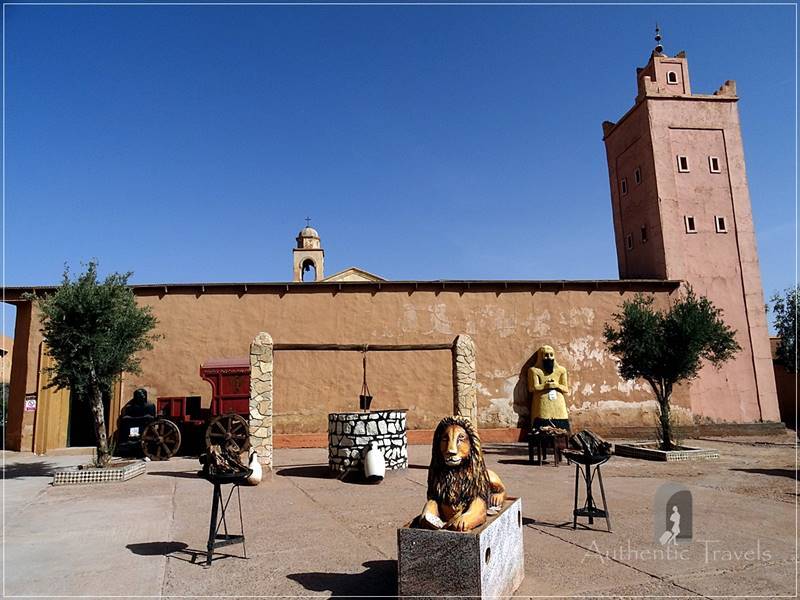
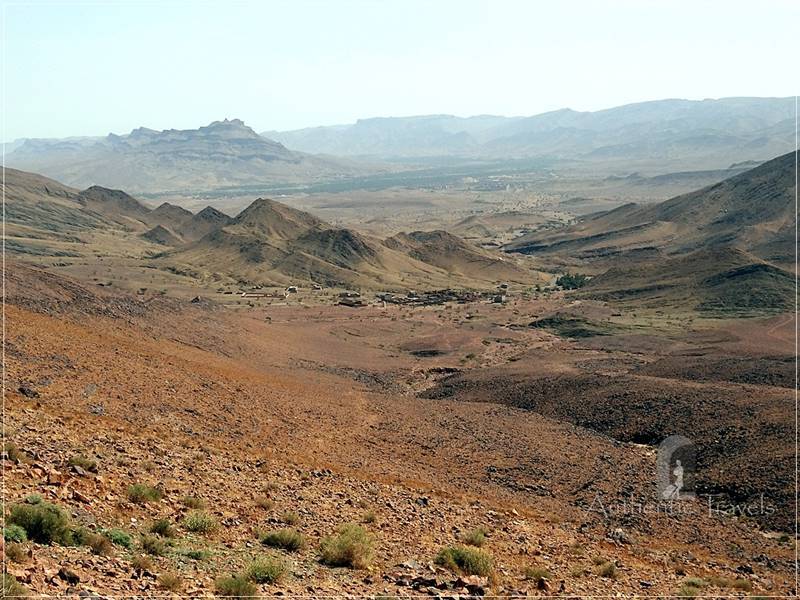
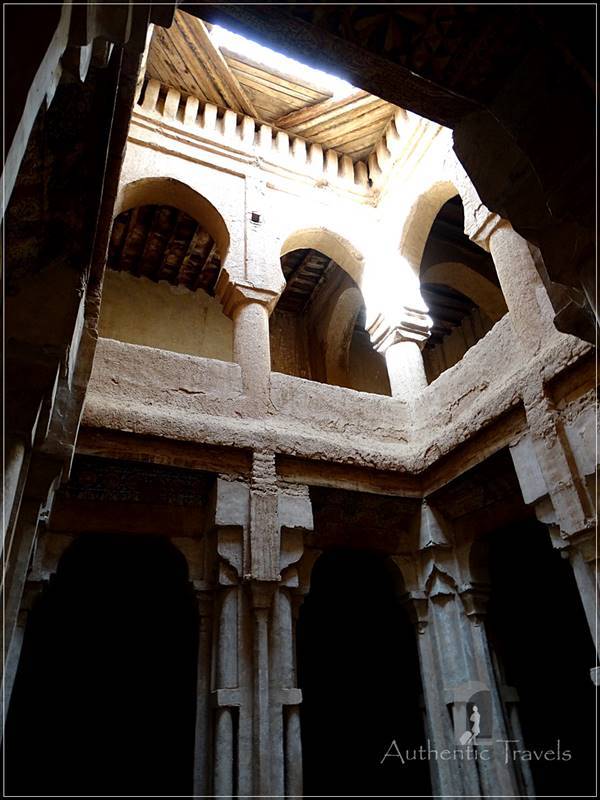
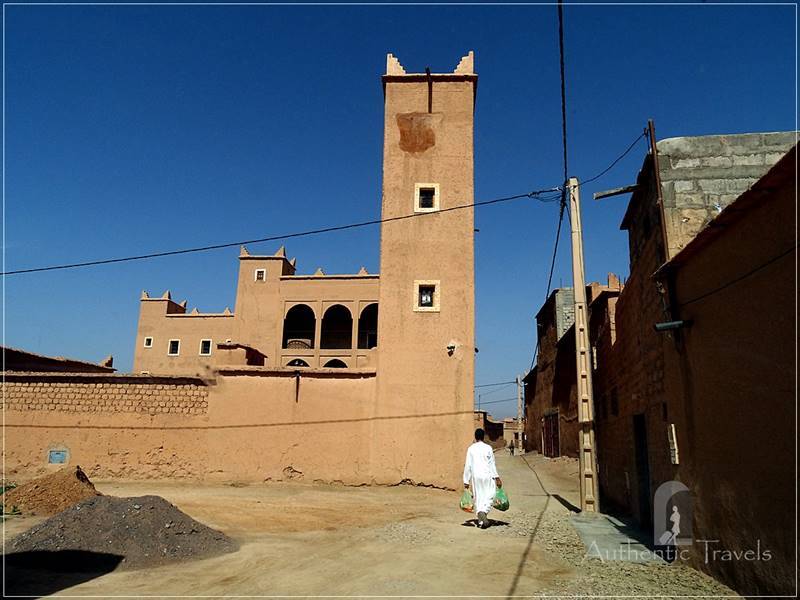
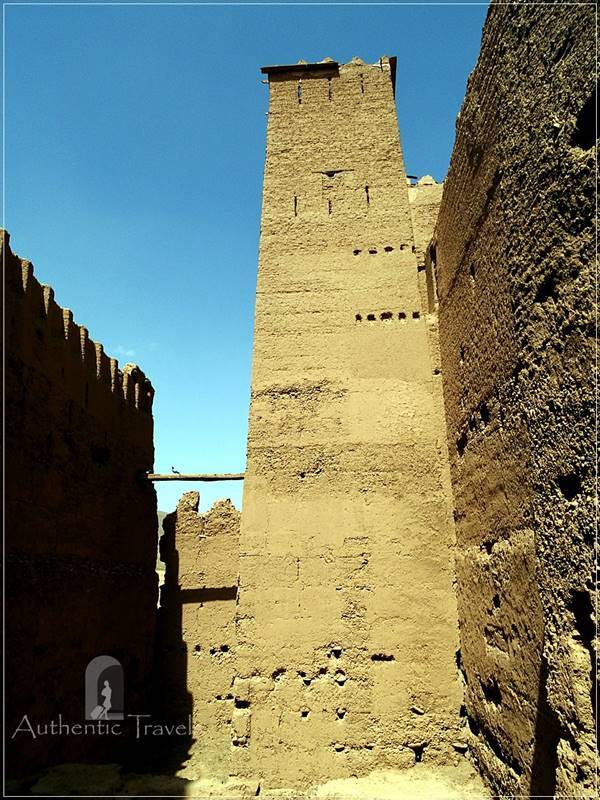
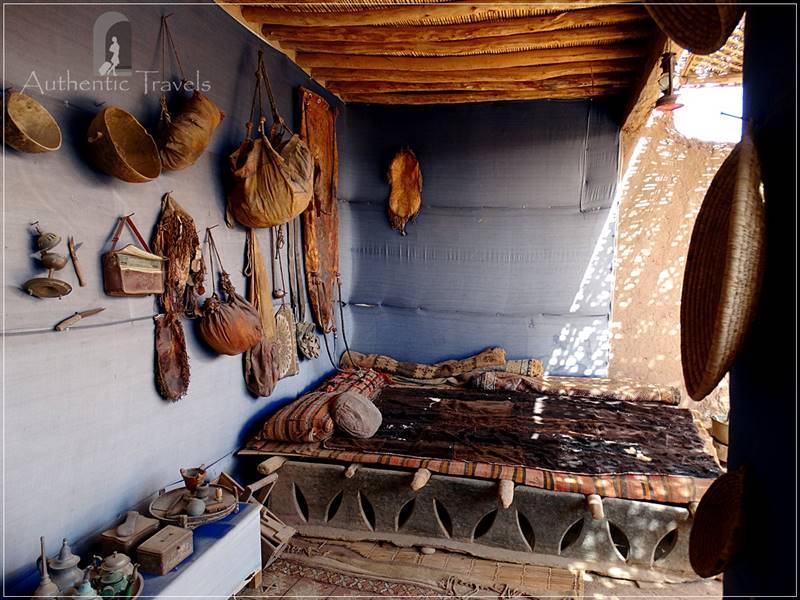
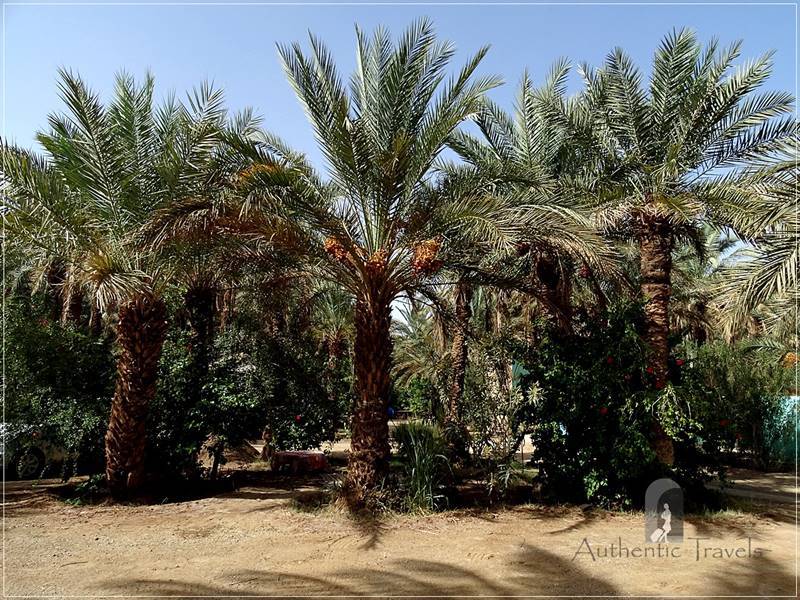
So jealous! Darcee & I spent over a month in Morocco and absolutely LOVED IT there…we got engaged in Casablanca. But sadly we missed out on Ouarzazate and Zagora. We just kind of ran out of time. We did some desert camping but from what I hear the camping spots around Zagor or in the Draa Valley look so amazing. Darcee would have loved exploring all the movie stuff in Ouarzazate but the camping was what I would have enjoyed the most. Definitely Jealous! Guess we need to go back! I heard that closer to the coast they also have some amazing surfing and kiteboarding sites too. So we just need to go back into the south for a month!
In the southern part of Morocco I regularly camped in official campsites, among palm trees – a true paradise. I am not into water sports but I guess that the Atlantic is a great challenge. I think you had a great engagement party in Casablanca. Congrats!
Nice blog. I visited Morocco a few years ago and thought about Ouarzazate but didn’t go. Seems like an interesting route and a good way to experience the real (authentic) Morocco. Appreciate the honest review of your trip.
Next time you will have to include the Draa Valley on your trip – seeing those mudbrick kasbahs and ksars is a unique experience.
I’m so glad I came across this post! I’m planning to visit Morocco in September and even though I (almost) already planned my trip, I’m looking for a few more suggestions of places to visit and things to do. I haven’t heard about Draa Valley or Zagora but after reading this, I might just add them to my itinerary. Thank you for sharing
The Draa Valley it worth a visit especially for the mud brick villages you find along the way. They are the real, authentic image of southern Morocco.
This is a very informative post. I haven’t been to Morocco yet, but I hope to get there one day. I’m interested in seeing the culture firsthand, visiting the beautiful dessert and trying out the local foods. It also looks like a photographers’ paradise!
The light is so great for shooting photos in Morocco. And you will find tajine – their national dish in all sorts of combinations, so you won’t miss it. Lamb tajine with olives is my favorite.
The Atlas Film Studios sound like a fun place to visit. Very cool that your guide was in a movie scene alongside Brad Pitt. Have you watched the movie to see if you can spot him?
I tried to find the movie on internet but wasn’t successful until now. I must try to find it again! 🙂
The museum with cinema artifacts looks so interesting. Even the outside is intriguing! I’ve never been to Morocco and have only done a safari in Africa. I’d love to explore more!
You have to do a safari in Morocco too. Exploring the hidden places of this country is amazing.
What a wonderful adventure, the Draa Valley looks gorgeous. Kasbah Caid sounds like an interesting visit. I love the architecture of the fortified village of Tamnougalt, great to discover some of the history. This is a great guide to the route you took, it’s bookmarked.
I always like to explore and discover off the beat places. The Draa Valley has so many of them.
I’ve always seen beautiful pictures of Morocco and I do want to go. But to be honest, I’m a little intimidated especially after hearing some negative experiences from solo female travelers. You also mentioned how the local men/guides are very persistent. I know I will go eventually but for now, I will continue reading tips & guides for traveling in Morocco to better equip myself.
I hear you and to be honest no matter how many tips and tricks you read, you won’t blow away that fear. Fear is overcame with courage. So as long as everybody says you are safe in Morocco, the only way to go there is to don’t think of your fears anymore.
I haven’t made it to Morocco yet, but when I do I might just have to add Draa Valley to the list. Thank you for being so raw recounting your experiences. I would also love to take a desert expedition on camel back – that must have been amazing.
Camel trek in the desert is my first choice. I would never give up such a thing – it’s amazing.
This is a very interesting part of the world that I’d very much like to visit. Morocco has been on my list for a long time so I kind of envy you for this wonderful adventure. The Draa Valley looks like a gorgeous place to visit. I love the architecture of the fortified village of Tamnougalt. Too bad they don’t maintain he houses in the ‘ksar.’
They maintain the houses, it’s just that this is their way of maintaining them.
Sounds like a great trip. I would specifically love to visit Tamnougalt; the idea of visiting a fortified village from the 16th century really appeals to me. Cannot wait to get myself to Morocco!
I hope you will get there one day. It’s really amazing.
I am hoping to do this part of Morocco next on my next visit to this amazing country. Ouarzazate has always been on my list of places to travel to and to check out the scenery and landscape in the surrounding area. It looks a lot quieter touristy (which is good in my eyes, I love to go to quieter places and off the beaten track), and the museum you have shown looks like one I love to check out. I love the animals outside. It is so quirky and I am sure my young children would love to check this out.
Ouarzazate is one of the most touristic spots in the region, but, indeed, the villages and ksars around Ouarzazate are off the beaten track. Children will love camels walking freely in the desert.
I loved the Draa Valley when we were in Morocco, especially Tamnougalt, such an evocative place. Must have been a bit unsettling to have that person honk and you and follow you, though. I guess all experiences help cement memories of a place.
Yes, despite the fact that it is a bit annoying at that moment, visiting a country is the sum of its experiences – and bad experiences are part of it too.
I haven’t been to Morocco or any country like it – the names of the places always have my head spinning because they’re so different! It actually looks so gorgeous in the valley and how impressive that your guide had a cameo role with Brad Pitt. How fun!! The structures made out of mud seem interesting to see in person, too. What a fabulous trip you had!
I was amazed to hear Rachid’s story too. They were so proud Brad Pitt came there, it was a big event for them.
Oh my God Draa Valley looks so beautiful. I was supposed to travel to Morocco last year, extending my 6 weeks backpacking trip in Europe. But unfortunately, I had to cancel for some reason and I could not see Morocco. I would love to go there someday and see these amazing places. I love Nkob too and would love to add it to my list.
N’Kob is a great place and I was the only tourist. I totally recommend it for an authentic experience.